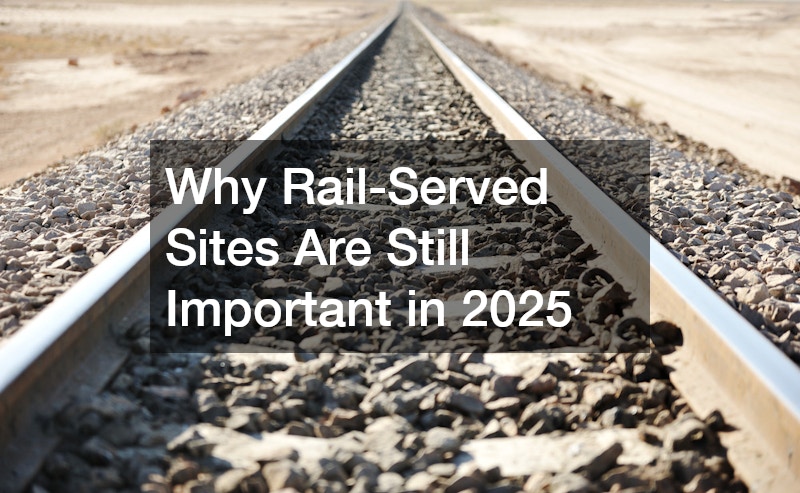In the rapidly evolving landscape of logistics and transportation, rail-served sites remain a vital component, even in 2025. Despite advancements in technology and the growth of alternative transport modes, rail-served sites continue to play a crucial role in efficient supply chain management. Their enduring significance is underpinned by a combination of economic, environmental, and logistical factors that ensure they remain relevant to modern industry needs. Railways offer unparalleled advantages in bulk transport of goods, thereby reducing dependency on road networks and lowering transportation costs.
In essence, rail-served sites are infrastructure assets that continue to provide sustainable solutions for industries across the globe.
With urbanization and industrialization on the rise globally, the demand for efficient transportation solutions has become more pronounced. Rail-served sites provide the necessary infrastructure to connect manufacturing centers, distribution hubs, and end markets seamlessly. Their strategic location and integration within industrial zones enable industries to optimize their supply chain processes, reduce lead times, and enhance operational efficiency. Furthermore, the ability of rail to move large quantities of goods at once makes it an indispensable component in the swift and reliable transfer of commodities. As industries expand, rail-served sites become pivotal in sustaining economic growth by supporting large-scale logistical operations.
Moreover, rail-served sites are increasingly seen as a green alternative in the pursuit of sustainability. The environmental benefits of rail transportation, as compared to road and air, are well-documented—rail produces significantly lower greenhouse gas emissions per ton-mile. This not only makes rail an eco-friendly option but also positions it as a key player in achieving corporate sustainability goals. Governments and organizations are continuously advocating for infrastructure that reduces the carbon footprint, and rail-served sites fit perfectly into this vision. Therefore, in 2025, rail-served sites are indispensable as industries aim to strike a balance between economic vitality and environmental stewardship.
The Economic Benefits of Rail-Served Sites
The economic importance of rail-served sites in 2025 cannot be overstated. These infrastructures serve as critical junctions in the commercial supply chain, enabling the movement of goods across vast distances efficiently and economically. Businesses relying on heavy and bulky freight benefit from the lower costs associated with rail transport compared to other modes, such as trucking or air freight. Additionally, the economies of scale provided by rail transportation are unmatched, allowing companies to capitalize on bulk shipping discounts and reduce per-unit costs significantly. Rail-served sites also offer a strategic advantage in market competitiveness, ultimately supporting industry growth and job creation.
Furthermore, rail-served sites contribute to the stabilization of regional economies by creating hubs of commercial activity. These sites attract various businesses, from manufacturers to logistics firms, leading to increased employment opportunities in the surrounding areas. The presence of rail infrastructure draws investment and stimulates local economies, leading to the development of related services and industries. Moreover, rail-served sites can mitigate congestion issues in urban centers by redistributing freight movement, reducing reliance on overburdened road networks. As a result, they play a critical role in maintaining efficient and sustainable urban environments.
With the growth of global trade, industries are increasingly prioritizing the efficiency and reliability of their supply chains. Rail-served sites, by facilitating direct rail access, help industries maintain robust logistical networks essential for global export and import activities. The strategic positioning of these sites within industrial clusters enhances connectivity to international markets, thus supporting cross-border commerce. This infrastructure investment helps businesses remain competitive on a international scale while adapting to the ever-changing demands of global markets. Consequently, the economic landscape in 2025 continues to rely heavily on the capabilities and advantages of rail-served sites.
The Logistical Advantages of Rail-Served Sites
From a logistical perspective, the advantages offered by rail-served sites are numerous. They enable seamless integration of different modes of transportation, including intermodal connections that facilitate efficient movement of goods from origin to destination. Rail-served sites are equipped to handle a variety of cargo types, making them versatile nodes within the supply chain. Moreover, their role in reducing congestion on highways and mitigating the urban transport challenges cannot be understated. By offering a reliable alternative to road transportation, these sites play a crucial role in ensuring timely delivery of goods and maintaining supply chain consistency.
Modern logistics operations depend on precision and efficiency, where every minute counts toward meeting consumer demand. Rail-served sites are designed with state-of-the-art facilities that streamline loading and unloading processes, thus minimizing dwell times and optimizing throughput. The integration of technology within these sites enhances real-time tracking and monitoring capabilities, ensuring that freight moves seamlessly across the transport network. Consequently, businesses can achieve higher levels of operational control and flexibility, adapting to sudden changes in market conditions or consumer preferences. In 2025, the logistical advantages provided by rail-served sites continue to support efficient transport networks that are resilient to evolving challenges.
The strategic location of rail-served sites within industrial corridors is key to their logistical success. These sites provide direct access to critical raw materials and consumer markets, significantly decreasing transportation bottlenecks and delays. By being close to major manufacturing hubs, they lower the logistics costs associated with last-mile deliveries and improve overall supply chain responsiveness. The use of rail-served sites enhances the ability of businesses to respond quickly to disruptions, whether they arise from natural disasters or market shifts. In the fast-paced logistics arena, the role of these sites remains significant as firms strive to provide timely, cost-efficient services to their customers.
The Environmental Role of Rail-Served Sites
One of the defining features of rail-served sites in 2025 is their contribution to environmental sustainability. As businesses and governments work collaboratively towards reducing carbon emissions, the transport sector is under pressure to adopt greener practices. Rail transport, known for its energy efficiency, offers a sustainable solution with a smaller carbon footprint compared to road or air freight. By utilizing electrically powered locomotives and advanced rail technologies, these sites help minimize the environmental impact of large-scale goods movement. This shift towards more eco-friendly practices aligns with global sustainability targets and helps preserve natural resources for future generations.
The operation of rail-served sites is aligned with the growing emphasis on corporate social responsibility (CSR) among businesses worldwide. Companies increasingly prioritize sustainable logistics choices as part of their CSR agenda, and rail infrastructure supports these commitments effectively. By opting for rail-served sites, businesses contribute to reducing dependency on fossil fuels and mitigating climate change effects. These benefits are not only limited to large corporations; smaller ventures also reap the ecological advantages, enhancing their brand reputation and consumer trust. In this context, the importance of rail-served sites in promoting a greener planet remains irrefutable.
Furthermore, the development and modernization of rail-served sites involve practices that minimize environmental disruption. Initiatives such as recycling construction materials, maintaining biodiversity on site, and implementing noise and pollution controls are embedded within these projects. The proactive approach of railway companies in integrating sustainability into their operations extends to community outreach and environmental stewardship programs. These efforts ensure that the growth of rail-served sites supports broader ecological health and community resilience. As sustainability remains at the forefront of strategic planning in 2025, the role of these sites in fostering a sustainable environment is fundamentally vital.
In conclusion, rail-served sites continue to be a cornerstone of the transportation and logistics landscape in 2025. Their multifaceted benefits across economic, logistical, and environmental dimensions position them as critical assets amid evolving industry challenges and opportunities. As industries and governments tackle emerging global priorities, rail-served sites offer solutions that align with sustainability goals, economic growth, and logistical efficiency. By providing the necessary infrastructure for large-scale goods movement, these sites remain indispensable to industries aiming to optimize their operations and maximize their competitive edge.
The future of rail-served sites looks promising as continuous advancements in rail technology and infrastructure innovation come to fruition. Investment in railway modernization and expanded services will likely enhance their capacity to respond to the changing demands of global trade and commerce. While road and air transport play essential roles in the supply chain ecosystem, rail-served sites uniquely offer economies of scale and reduced environmental impacts that are hard to replicate. Thus, as we look towards the future, it is evident that rail-served sites hold a critical place in the sustainable development of our global industries.
Overall, as the world progresses towards a more integrated and sustainable framework for commerce and supply chain management, the relevance of rail-served sites continues to grow. Their importance extends beyond mere logistical function; they are a vital part of the fabric that supports socioeconomic development and global resilience. In the years to come, industries, policymakers, and communities will increasingly recognize the value of rail-served sites, ensuring their continued significance and indispensable contribution to the modern world.


